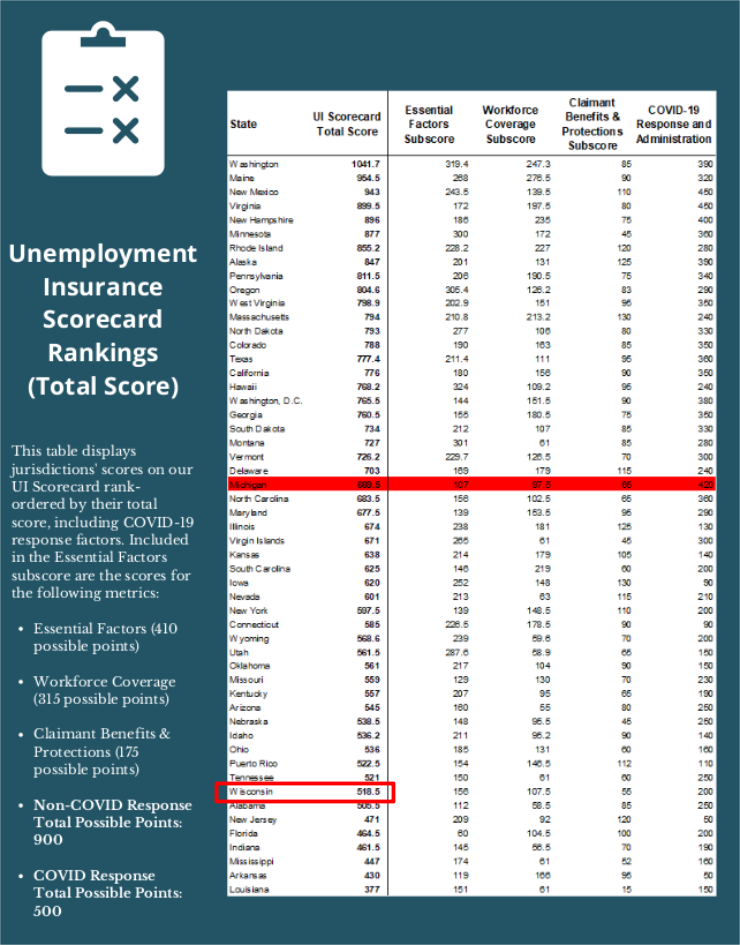Note: Previous posts detailed the length of time and number of cases in the unemployment backlog in part 1, some of the mistakes by the Department that allow cases to be re-opened in part 2, a place for stories and advice about how to find assistance in part 3, how most claims in Wisconsin — and unlike in other states — are being denied and thereby creating a ginormous backlog in hearings in part 4, in part 5 how the Department’s big push to fix the backlog in December 2020 was creating a hearings backlog and not addressing the root causes of all the delays, in part 6 how a December 2020 push had cleared some of the back log with issuing initial determinations but that the hearings backlog was growing because most claims were being denied and that claimants were losing most of their hearings, how the phone support system still fails to operate effectively a year later in part 7, and a summary in part 8 of how poor policy choices and guidance by the Department have led to numerous delays and confusion.
Claimants ask me nearly every day about something appearing on their portal and wanting me to explain this portal issue. Frankly, no one can explain the portal because the information presented there is just NOT accurate or even understandable. Only if you understand unemployment law and what has happened in your case can the portal begin to make sense, and even then that outcome is a long shot.
To illustrate this confusion, let me present a pretty typical example of what claimants are experiencing and seeing with their unemployment claims.
Claimant Sue filed an initial claim for PUA benefits when her work schedule was reduced in April 2020 because of the pandemic. She had to apply for PUA benefits because she could not establish a benefit year (i.e., monetary eligibility) for receiving regular unemployment benefits, as she had not worked enough in 2019 (only a few weeks at a job before quitting).
A PUA benefit year calculation was issued on 24 July 2020 finding that her earnings were so low that she qualified for the minimum PUA weekly benefit rate of $163. She then filed a PUA weekly certification for the week her work was reduced, the week ending 4/11/2020, reporting 16 hours of work and $200 in earnings that week.
As with most PUA claimants, her PUA initial claim was then denied in a second initial determination that she appealed. The hearing in that case did not occur until May 2021. In that case, the administrative law judge ruled that she had a pandemic-related job loss but indicated that she might qualify for regular unemployment based on an alternative benefit year calculation and that she had to file a new initial claim for regular unemployment benefits back-dated to the week ending 4/11/2020. So, she “won” the hearing but no payment would be forthcoming until she did as directed.
Dutifully, that same month she called a claim specialists and filed an initial claim for regular unemployment benefits and then waited for a resolution.
In the meantime, however, the Department issued two more determinations finding (1) that the job she quit in July 2020 disqualified her from receiving unemployment benefits and (2) that the quit in July 2020 also disqualified her from receiving PUA benefits. Confused over what these new initial determinations meant, she appealed both and had hearings on both. The administrative law judge ruled against her in both cases and she appealed to the Labor and Industry Review Commission.
And, it turned out that the May 2021 attempt to file an initial claim for regular unemployment did not work (a second weekly certification for the same week was filed instead by mistake). So, in September 2021, when that mistake was discovered, another regular unemployment initial claim was filed.
Then, in November 2021, two benefit year calculations were issued, one for a traditional benefit year and another for an alternative benefit year. The traditional benefit year calculation found no eligibility for regular unemployment benefits. But, the alternative benefit year calculation found that Sue had established a benefit year with a weekly benefit rate of $71. Because her earnings in the week ending 4/11/2020 were $200, she earned too much that week relative to her $71 weekly benefit rate to receive any unemployment benefits that week. So, no PUA eligibility (because she had established eligibility for regular unemployment benefits) and no regular unemployment benefits paid out because she had too much earnings for the week being claimed.
The claimant’s portal, on the other hand, does not reflect this information. Here is the determinations history for Sue

There are six entries here, and this information is both incomplete and misleading. From top to bottom, here are the problems:
- Determination for UI week 15/2020: This information is for the traditional benefit year calculation that found Sue did not establish a benefit year. There is no ability to see the actual document being described here. Furthermore, this document is moot, since an alternative benefit year calculation found Sue eligible for regular unemployment benefits with a weekly benefit rate of $71. But, there is no listing of that determination here.
- Determination for UI week 31/2020: This determination is for the alleged denial of PUA benefits for a quit that occurred in July 2020. The text about “reviewing for additional wages to satisfy a suspension/denial” is a legalism that only makes sense to a person who knows that a quit without good cause means eligibility for unemployment benefits is suspended until a claimant earns 6x his or her weekly benefit rate in subsequent work. This legalism is nonsensical because the denial here is for PUA eligibility — whether a person has a qualifying pandemic-related job loss. So, none of this explanation provides any information that is helpful.
- Determination for UI week 31/2020: This determination is for Sue quitting a job in July 2020 and that the Department found that she quit for reasons that would not allow for payment of regular unemployment benefits. The Department is NOT reviewing this information. It issued an initial determination finding that Sue quit without good cause, which Sue appealed, lost at a hearing, and which Sue then appealed to the Labor and Industry Review Commission.
- Determination for UI week 15/2020: This determination is for PUA eligibility and reflects the decision of the administration of the administration law judge that was issued in May of 2021. The determination linked to here, however, found that the claimant did not have a pandemic-related job loss. The actual hearing decision, on the other hand, found Sue eligible for PUA benefits IF she could not establish benefit year eligibility for regular unemployment benefits. That hearing decision is NOT available on the portal. Sue just has to know that an appeal tribunal decision reversed this initial determination and that the reference to PUA eligibility in this entry is because of that hearing decision. The same confusing description of the issue from determination #2 is repeated here and is just nonsensical.
- Determination for UI week 36/2019: Recall that Sue had a previous job for a few weeks in 2019 that she quit. As stated here, the Department concluded that Sue earned 6x her weekly benefit rate so that the disqualification no longer mattered. There is no actual initial determination document that can be viewed, however, and no way to know what weekly benefit rate was used by the Department in determining that this quit disqualification no longer mattered.
- Determination for UI week 15/2020: The determination here is the one that found the claimant had no earnings and so qualified for the minimum PUA weekly benefit rate of $163. Determination #4, however, had over-turned this initial determination, but then a decision by an administrative law judge had over-turned that initial determination. So, this entry indicates that the claimant is eligible for PUA benefits and has not established enough earnings to qualify for regular unemployment benefits without dealing with any of the “issues” that came after it.
Because these entries are listed by UI week and not the actual initial determination numbers or in some kind of chronological ordering that connects to claimant’s actual work history or claim-filing history (rather than, as is happening here, when the Department first “decided” the issue), claimants can think all of these issues still apply to them in some way.
For instance, the Sues of the world will ask me to explain why they are not receiving PUA benefits because of entry #6 or entry #4 or entry #1. And, there is no way I can answer that kind of question without getting the actual history of what has happened with Sue’s claim-filing and unemployment litigation as initially described here.
But, the biggest problem here is that the alternative benefit year calculation that found Sue eligible for regular unemployment with a weekly benefit rate of $71 is missing in action.
The determinations and appeals information on the portal is just as confusing.

Recall that Sue filed three appeals of initial determinations and that one appeal was won in May 2021 at a hearing before an administrative law judge and that two other cases were appealed to the Labor and Industry Review Commission after she lost those hearings. This “appeals” page, however, has four entries: two determinations and two appeals. Here is how this information matches up with the determinations history page described above.
- Determination for UI Week 31/2020: This entry matches entry #2 above under determinations history. As with that entry, the “quit” at the center of this case is nowhere to be found. This case, however, was appealed and, after a hearing, a decision by an administrative law judge affirming the initial determination was issued. That decision was subsequently appealed. See entry #3, below.
- Determination for UI Week 31/2020: This entry matches entry #3 above under determinations history.
- Appeal for UI Week 31/2020: This hearing information is for the PUA/quit case described in entry #1 of this page.
- Appeal for UI Week 31/2020: This hearing information is for the quit case described in entry #2 of this page.
Notice that there is no information whatsoever about the PUA eligibility appeal and hearing decision in Sue’s favor’s in entry #4 under determinations history. Since this case is excluded from Sue’s portal, it is apparent that the Department has concluded that this case is no longer significant, even though it is this case which drives the Department to allow Sue to file late initial claims for regular unemployment benefits and to eventually find that she qualifies for regular unemployment benefits using an alternate benefit year calculation.
Indeed, Sue’s UI benefit summary only makes sense in light this missing appeal information.

Nothing on this UI Summary Page makes sense in light of the other two screenshots from the portal. Here, Sue can see that she qualifies for a weekly benefit rate of $71 for a benefit year that goes from 4/5/2020 to 4/3/2021 and that her “status” for the weekly certification filed for the week 4/5/2020 to 4/11/2020 is “Earned Too Much Money.” Interestingly, the statement here under “Issues and Determinations” about “You have determinations preventing payment.” is wrong. As stated under “Payment Information,” Sue would have received regular unemployment benefits if she had not earned too much money that week. The portal does not explain or identify in any way how she is now eligible for regular unemployment benefits at the rate of $71 per week.
All that Sue can see is that she is denied eligibility and that she has pending appeals. From this information, Sue thinks that her current appeals, if won, will lead to the payment of PUA benefits.
In another sense, all of this confusion and misdirection is to be expected. The Department itself declares that the portal cannot be relied on as accurate. Click on the link on the bottom of the screen for Legal/Acceptable Use. At this new page, scroll down to the disclaimers and read (emphasis supplied):
Disclaimer of Warranties And Accuracy of Data
Although the data found using the State of Wisconsin’s access systems have been produced and processed from sources believed to be reliable, no warranty, expressed or implied, is made regarding accuracy, adequacy, completeness, legality, reliability or usefulness of any information. This disclaimer applies to both isolated and aggregate uses of the information. The State provides this information on an “as is” basis. All warranties of any kind, express or implied, including but not limited to the implied warranties of merchantability, fitness for a particular purpose, freedom from contamination by computer viruses and non-infringement of proprietary rights are disclaimed. Changes may be periodically made to the information herein; these changes may or may not be incorporated in any new version of the publication. If you have obtained information from any of the State’s web pages from a source other than the State pages, be aware that electronic data can be altered subsequent to original distribution. Data can also quickly become out of date. It is recommended that careful attention be paid to the contents of any data associated with a file and that the originator of the data or information be contacted with any questions regarding appropriate use. If you find any errors or omissions, we encourage you to report them to Wisconsin.gov.
Here is a complete PDF of these policies. Through this disclaimer, the Department is specifically denying that any information on the portal can be considered accurate, complete, reliable, or even useful as to your unemployment claim or unemployment law in general.
Given how inaccurate the portal actually is, this disclaimer makes sense. Indeed, if the Department disclaims any requirement to provide claimants with accurate information, then why in the world should claimants think that this information is accurate in the first place? Maybe they shouldn’t.











